BUSINESS ACCOUNTING - Break-even Analysis, Costing, Final Accounts, Ratio Analysis
VerifiedAdded on 2024/04/25
|19
|2820
|487
AI Summary
This comprehensive guide covers break-even analysis, costing techniques, significance of final accounts, and evaluation of financial state through ratio analysis in business accounting.
Contribute Materials
Your contribution can guide someone’s learning journey. Share your
documents today.

BUSINESS ACCOUNTING
1
1
Secure Best Marks with AI Grader
Need help grading? Try our AI Grader for instant feedback on your assignments.
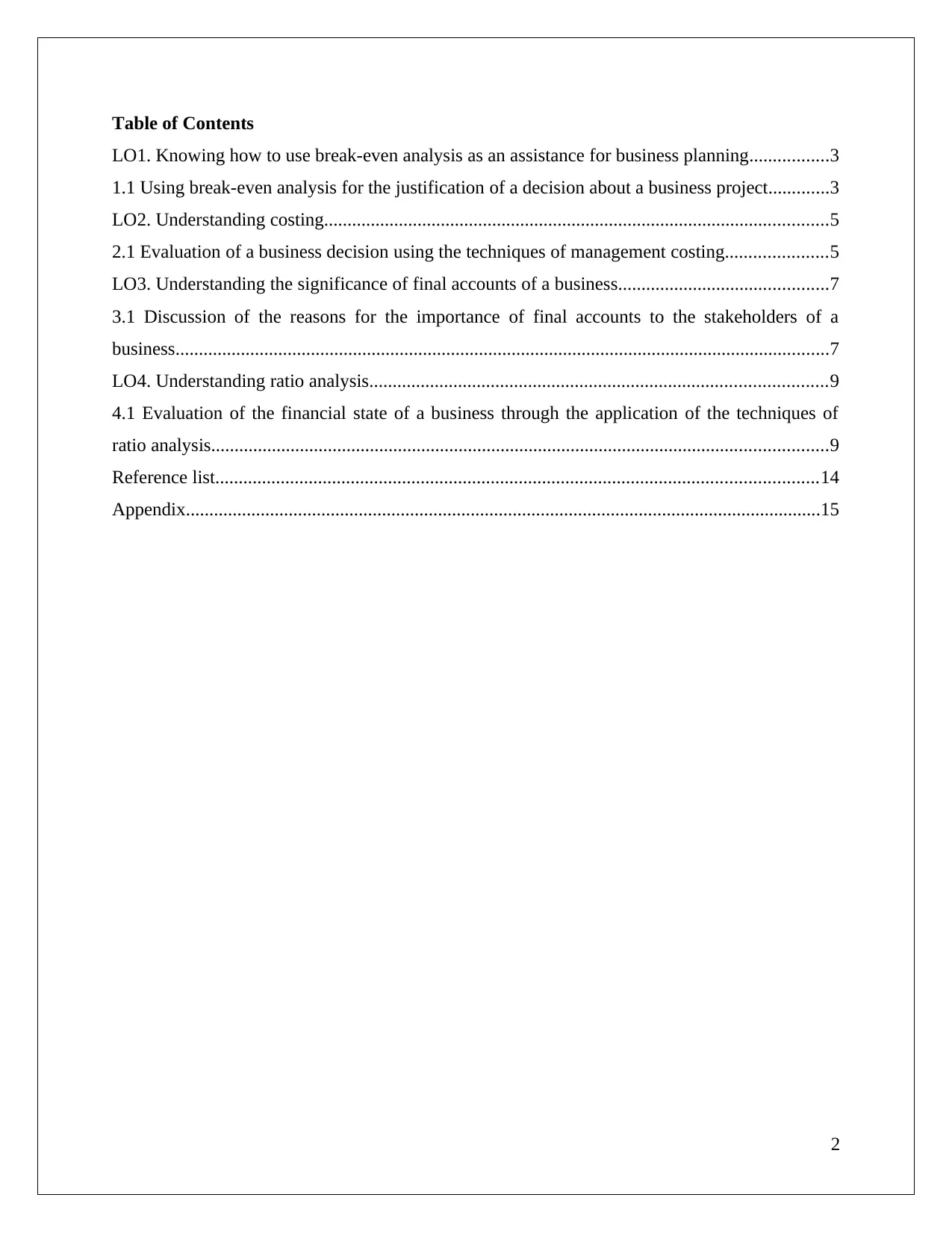
Table of Contents
LO1. Knowing how to use break-even analysis as an assistance for business planning.................3
1.1 Using break-even analysis for the justification of a decision about a business project.............3
LO2. Understanding costing............................................................................................................5
2.1 Evaluation of a business decision using the techniques of management costing......................5
LO3. Understanding the significance of final accounts of a business.............................................7
3.1 Discussion of the reasons for the importance of final accounts to the stakeholders of a
business............................................................................................................................................7
LO4. Understanding ratio analysis..................................................................................................9
4.1 Evaluation of the financial state of a business through the application of the techniques of
ratio analysis....................................................................................................................................9
Reference list.................................................................................................................................14
Appendix........................................................................................................................................15
2
LO1. Knowing how to use break-even analysis as an assistance for business planning.................3
1.1 Using break-even analysis for the justification of a decision about a business project.............3
LO2. Understanding costing............................................................................................................5
2.1 Evaluation of a business decision using the techniques of management costing......................5
LO3. Understanding the significance of final accounts of a business.............................................7
3.1 Discussion of the reasons for the importance of final accounts to the stakeholders of a
business............................................................................................................................................7
LO4. Understanding ratio analysis..................................................................................................9
4.1 Evaluation of the financial state of a business through the application of the techniques of
ratio analysis....................................................................................................................................9
Reference list.................................................................................................................................14
Appendix........................................................................................................................................15
2

LO1. Knowing how to use break-even analysis as an assistance for business planning
1.1 Using break-even analysis for the justification of a decision about a business project
Breakeven analysis is a technique in economics that involves the examination and computation
of the “margin of safety” of a company based on the associated costs and revenues collected by
the company (Richards, 2013). Through the analysis of the various price levels of a company
related to its various levels of demand, the company uses the breakeven analysis for determining
the level of sales required for covering the sum of all the fixed costs of the company. The
breakeven analysis helps a company in deriving a point at which the sales made or the revenues
earned by a company are equal to the costs spent by the company for production of goods.
The breakeven analysis plays an important role in decision-making (Drury, 2013). It especially
helps in the determination of the minimum sales that must be exceeded in order to make profit
from the business project. The breakeven analysis is useful for decision-making in a business
project as it helps in setting selling prices, management of costs and planning for profits. For
example, XYZ Ltd. Company wants to invest in a project of building a housing complex. The
investment for building a hotel is huge and thus the company requires effective decision-making
in order to find out whether project should be undertaken or not. The decision-making of this
project can be evaluated from the breakeven analysis in the following way –
The fixed costs and variable costs required for building the hotel is as follows –
FIXED COSTS VARIABLE COSTS
Labor $1500000 Labor $450
Insurance $300000 Raw Materials $190
Advertising $22000 Component parts $110
Utilities $3000
Total fixed costs $1825000 Total variable costs (per unit) $750
The cost of selling each flat is $1000 and the current level of sales is 8000 units. Therefore
breakeven point = Total fixed costs / Selling price of each unit – Variable cost of each unit =
3
1.1 Using break-even analysis for the justification of a decision about a business project
Breakeven analysis is a technique in economics that involves the examination and computation
of the “margin of safety” of a company based on the associated costs and revenues collected by
the company (Richards, 2013). Through the analysis of the various price levels of a company
related to its various levels of demand, the company uses the breakeven analysis for determining
the level of sales required for covering the sum of all the fixed costs of the company. The
breakeven analysis helps a company in deriving a point at which the sales made or the revenues
earned by a company are equal to the costs spent by the company for production of goods.
The breakeven analysis plays an important role in decision-making (Drury, 2013). It especially
helps in the determination of the minimum sales that must be exceeded in order to make profit
from the business project. The breakeven analysis is useful for decision-making in a business
project as it helps in setting selling prices, management of costs and planning for profits. For
example, XYZ Ltd. Company wants to invest in a project of building a housing complex. The
investment for building a hotel is huge and thus the company requires effective decision-making
in order to find out whether project should be undertaken or not. The decision-making of this
project can be evaluated from the breakeven analysis in the following way –
The fixed costs and variable costs required for building the hotel is as follows –
FIXED COSTS VARIABLE COSTS
Labor $1500000 Labor $450
Insurance $300000 Raw Materials $190
Advertising $22000 Component parts $110
Utilities $3000
Total fixed costs $1825000 Total variable costs (per unit) $750
The cost of selling each flat is $1000 and the current level of sales is 8000 units. Therefore
breakeven point = Total fixed costs / Selling price of each unit – Variable cost of each unit =
3
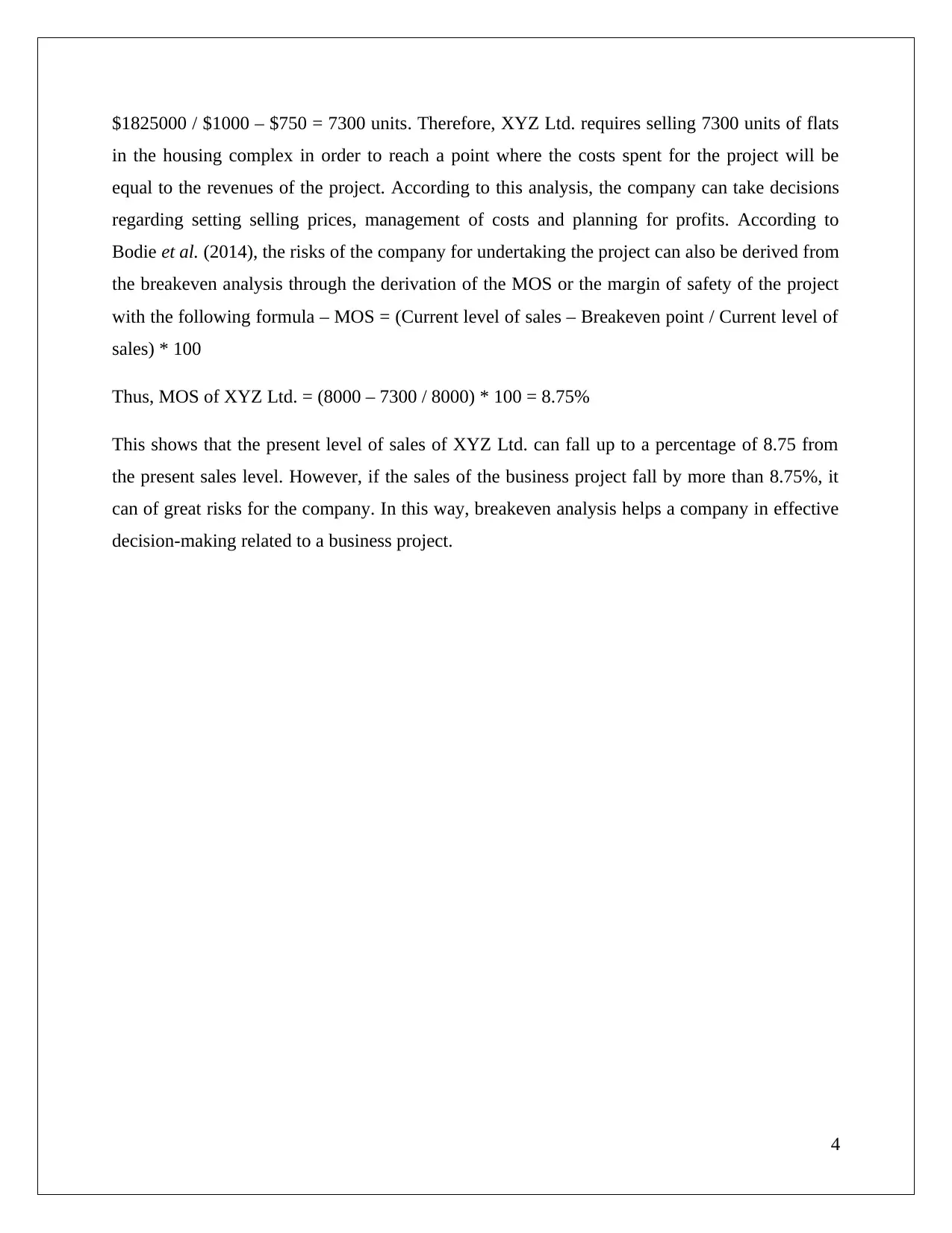
$1825000 / $1000 – $750 = 7300 units. Therefore, XYZ Ltd. requires selling 7300 units of flats
in the housing complex in order to reach a point where the costs spent for the project will be
equal to the revenues of the project. According to this analysis, the company can take decisions
regarding setting selling prices, management of costs and planning for profits. According to
Bodie et al. (2014), the risks of the company for undertaking the project can also be derived from
the breakeven analysis through the derivation of the MOS or the margin of safety of the project
with the following formula – MOS = (Current level of sales – Breakeven point / Current level of
sales) * 100
Thus, MOS of XYZ Ltd. = (8000 – 7300 / 8000) * 100 = 8.75%
This shows that the present level of sales of XYZ Ltd. can fall up to a percentage of 8.75 from
the present sales level. However, if the sales of the business project fall by more than 8.75%, it
can of great risks for the company. In this way, breakeven analysis helps a company in effective
decision-making related to a business project.
4
in the housing complex in order to reach a point where the costs spent for the project will be
equal to the revenues of the project. According to this analysis, the company can take decisions
regarding setting selling prices, management of costs and planning for profits. According to
Bodie et al. (2014), the risks of the company for undertaking the project can also be derived from
the breakeven analysis through the derivation of the MOS or the margin of safety of the project
with the following formula – MOS = (Current level of sales – Breakeven point / Current level of
sales) * 100
Thus, MOS of XYZ Ltd. = (8000 – 7300 / 8000) * 100 = 8.75%
This shows that the present level of sales of XYZ Ltd. can fall up to a percentage of 8.75 from
the present sales level. However, if the sales of the business project fall by more than 8.75%, it
can of great risks for the company. In this way, breakeven analysis helps a company in effective
decision-making related to a business project.
4
Secure Best Marks with AI Grader
Need help grading? Try our AI Grader for instant feedback on your assignments.
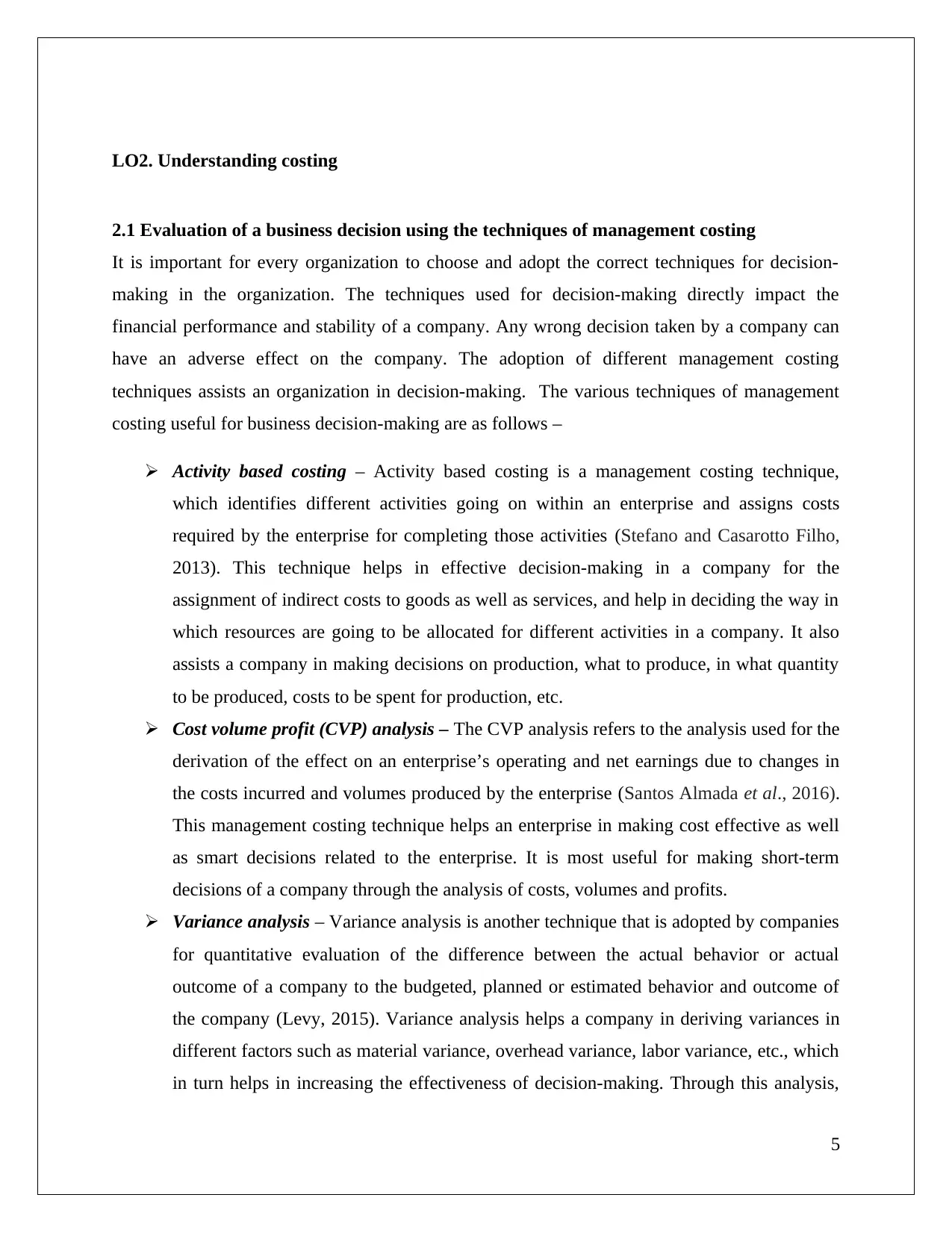
LO2. Understanding costing
2.1 Evaluation of a business decision using the techniques of management costing
It is important for every organization to choose and adopt the correct techniques for decision-
making in the organization. The techniques used for decision-making directly impact the
financial performance and stability of a company. Any wrong decision taken by a company can
have an adverse effect on the company. The adoption of different management costing
techniques assists an organization in decision-making. The various techniques of management
costing useful for business decision-making are as follows –
Activity based costing – Activity based costing is a management costing technique,
which identifies different activities going on within an enterprise and assigns costs
required by the enterprise for completing those activities (Stefano and Casarotto Filho,
2013). This technique helps in effective decision-making in a company for the
assignment of indirect costs to goods as well as services, and help in deciding the way in
which resources are going to be allocated for different activities in a company. It also
assists a company in making decisions on production, what to produce, in what quantity
to be produced, costs to be spent for production, etc.
Cost volume profit (CVP) analysis – The CVP analysis refers to the analysis used for the
derivation of the effect on an enterprise’s operating and net earnings due to changes in
the costs incurred and volumes produced by the enterprise (Santos Almada et al., 2016).
This management costing technique helps an enterprise in making cost effective as well
as smart decisions related to the enterprise. It is most useful for making short-term
decisions of a company through the analysis of costs, volumes and profits.
Variance analysis – Variance analysis is another technique that is adopted by companies
for quantitative evaluation of the difference between the actual behavior or actual
outcome of a company to the budgeted, planned or estimated behavior and outcome of
the company (Levy, 2015). Variance analysis helps a company in deriving variances in
different factors such as material variance, overhead variance, labor variance, etc., which
in turn helps in increasing the effectiveness of decision-making. Through this analysis,
5
2.1 Evaluation of a business decision using the techniques of management costing
It is important for every organization to choose and adopt the correct techniques for decision-
making in the organization. The techniques used for decision-making directly impact the
financial performance and stability of a company. Any wrong decision taken by a company can
have an adverse effect on the company. The adoption of different management costing
techniques assists an organization in decision-making. The various techniques of management
costing useful for business decision-making are as follows –
Activity based costing – Activity based costing is a management costing technique,
which identifies different activities going on within an enterprise and assigns costs
required by the enterprise for completing those activities (Stefano and Casarotto Filho,
2013). This technique helps in effective decision-making in a company for the
assignment of indirect costs to goods as well as services, and help in deciding the way in
which resources are going to be allocated for different activities in a company. It also
assists a company in making decisions on production, what to produce, in what quantity
to be produced, costs to be spent for production, etc.
Cost volume profit (CVP) analysis – The CVP analysis refers to the analysis used for the
derivation of the effect on an enterprise’s operating and net earnings due to changes in
the costs incurred and volumes produced by the enterprise (Santos Almada et al., 2016).
This management costing technique helps an enterprise in making cost effective as well
as smart decisions related to the enterprise. It is most useful for making short-term
decisions of a company through the analysis of costs, volumes and profits.
Variance analysis – Variance analysis is another technique that is adopted by companies
for quantitative evaluation of the difference between the actual behavior or actual
outcome of a company to the budgeted, planned or estimated behavior and outcome of
the company (Levy, 2015). Variance analysis helps a company in deriving variances in
different factors such as material variance, overhead variance, labor variance, etc., which
in turn helps in increasing the effectiveness of decision-making. Through this analysis,
5
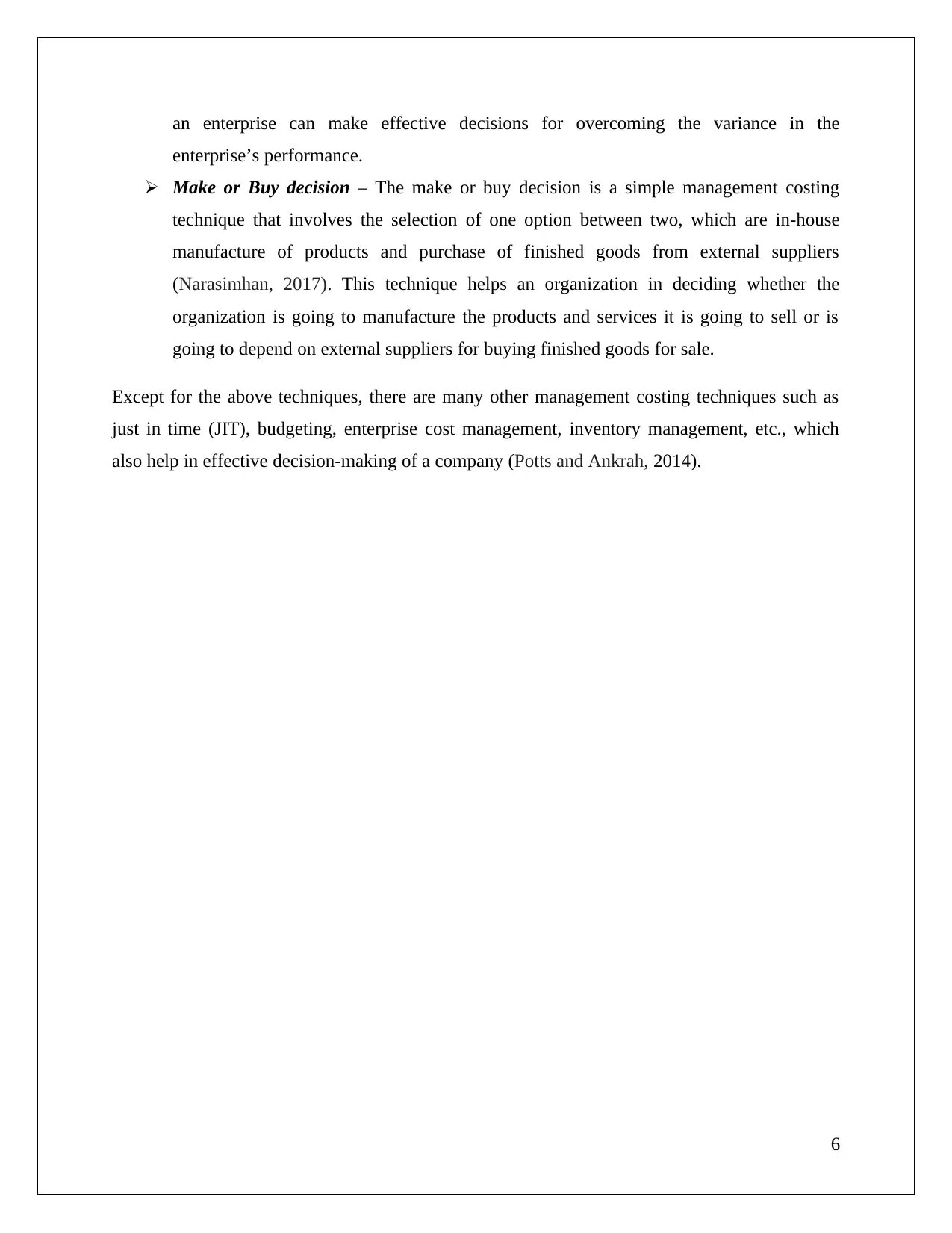
an enterprise can make effective decisions for overcoming the variance in the
enterprise’s performance.
Make or Buy decision – The make or buy decision is a simple management costing
technique that involves the selection of one option between two, which are in-house
manufacture of products and purchase of finished goods from external suppliers
(Narasimhan, 2017). This technique helps an organization in deciding whether the
organization is going to manufacture the products and services it is going to sell or is
going to depend on external suppliers for buying finished goods for sale.
Except for the above techniques, there are many other management costing techniques such as
just in time (JIT), budgeting, enterprise cost management, inventory management, etc., which
also help in effective decision-making of a company (Potts and Ankrah, 2014).
6
enterprise’s performance.
Make or Buy decision – The make or buy decision is a simple management costing
technique that involves the selection of one option between two, which are in-house
manufacture of products and purchase of finished goods from external suppliers
(Narasimhan, 2017). This technique helps an organization in deciding whether the
organization is going to manufacture the products and services it is going to sell or is
going to depend on external suppliers for buying finished goods for sale.
Except for the above techniques, there are many other management costing techniques such as
just in time (JIT), budgeting, enterprise cost management, inventory management, etc., which
also help in effective decision-making of a company (Potts and Ankrah, 2014).
6
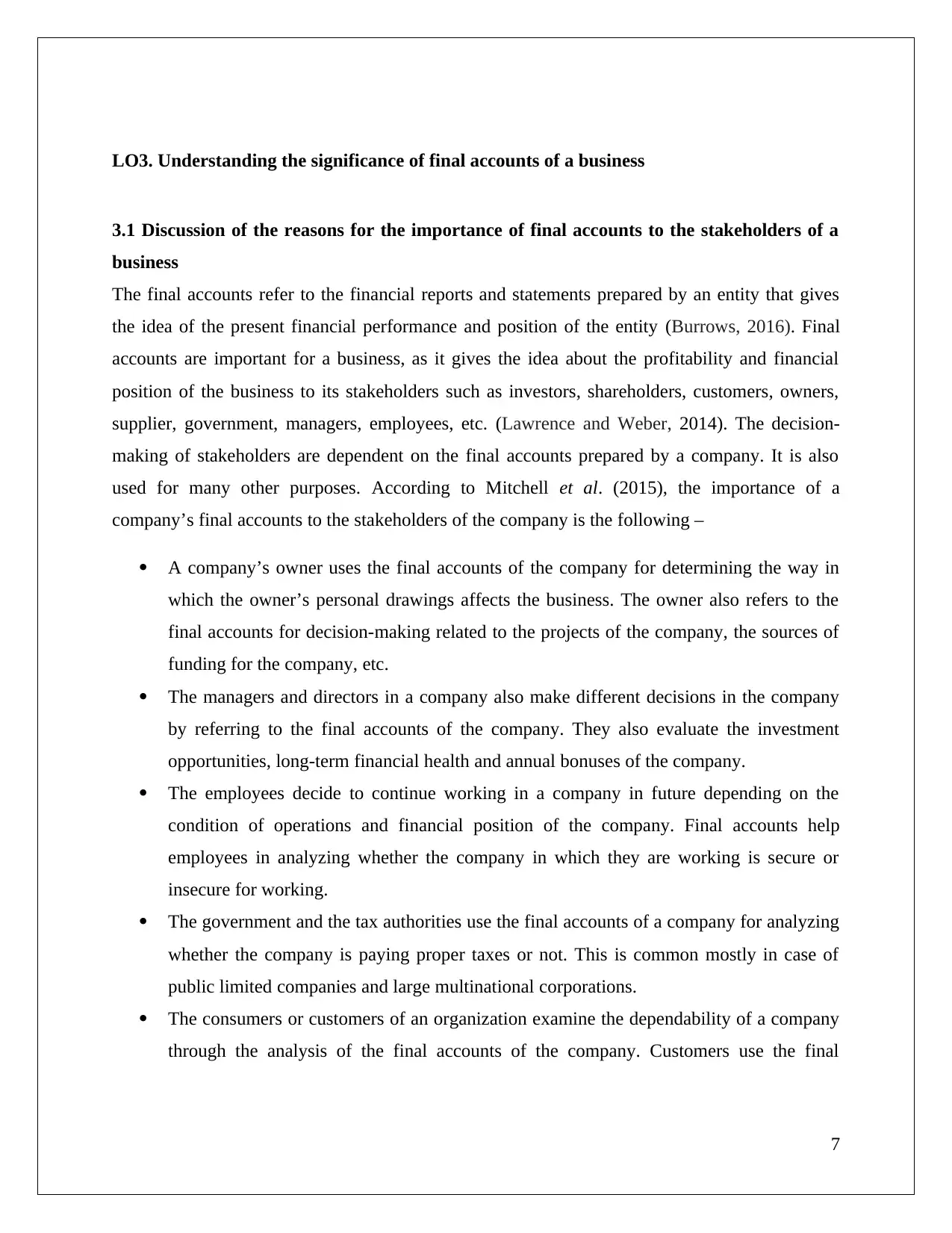
LO3. Understanding the significance of final accounts of a business
3.1 Discussion of the reasons for the importance of final accounts to the stakeholders of a
business
The final accounts refer to the financial reports and statements prepared by an entity that gives
the idea of the present financial performance and position of the entity (Burrows, 2016). Final
accounts are important for a business, as it gives the idea about the profitability and financial
position of the business to its stakeholders such as investors, shareholders, customers, owners,
supplier, government, managers, employees, etc. (Lawrence and Weber, 2014). The decision-
making of stakeholders are dependent on the final accounts prepared by a company. It is also
used for many other purposes. According to Mitchell et al. (2015), the importance of a
company’s final accounts to the stakeholders of the company is the following –
A company’s owner uses the final accounts of the company for determining the way in
which the owner’s personal drawings affects the business. The owner also refers to the
final accounts for decision-making related to the projects of the company, the sources of
funding for the company, etc.
The managers and directors in a company also make different decisions in the company
by referring to the final accounts of the company. They also evaluate the investment
opportunities, long-term financial health and annual bonuses of the company.
The employees decide to continue working in a company in future depending on the
condition of operations and financial position of the company. Final accounts help
employees in analyzing whether the company in which they are working is secure or
insecure for working.
The government and the tax authorities use the final accounts of a company for analyzing
whether the company is paying proper taxes or not. This is common mostly in case of
public limited companies and large multinational corporations.
The consumers or customers of an organization examine the dependability of a company
through the analysis of the final accounts of the company. Customers use the final
7
3.1 Discussion of the reasons for the importance of final accounts to the stakeholders of a
business
The final accounts refer to the financial reports and statements prepared by an entity that gives
the idea of the present financial performance and position of the entity (Burrows, 2016). Final
accounts are important for a business, as it gives the idea about the profitability and financial
position of the business to its stakeholders such as investors, shareholders, customers, owners,
supplier, government, managers, employees, etc. (Lawrence and Weber, 2014). The decision-
making of stakeholders are dependent on the final accounts prepared by a company. It is also
used for many other purposes. According to Mitchell et al. (2015), the importance of a
company’s final accounts to the stakeholders of the company is the following –
A company’s owner uses the final accounts of the company for determining the way in
which the owner’s personal drawings affects the business. The owner also refers to the
final accounts for decision-making related to the projects of the company, the sources of
funding for the company, etc.
The managers and directors in a company also make different decisions in the company
by referring to the final accounts of the company. They also evaluate the investment
opportunities, long-term financial health and annual bonuses of the company.
The employees decide to continue working in a company in future depending on the
condition of operations and financial position of the company. Final accounts help
employees in analyzing whether the company in which they are working is secure or
insecure for working.
The government and the tax authorities use the final accounts of a company for analyzing
whether the company is paying proper taxes or not. This is common mostly in case of
public limited companies and large multinational corporations.
The consumers or customers of an organization examine the dependability of a company
through the analysis of the final accounts of the company. Customers use the final
7
Paraphrase This Document
Need a fresh take? Get an instant paraphrase of this document with our AI Paraphraser

accounts of a company for promoting the company and maintaining their loyalty to the
company.
The rival companies use final accounts of a company for comparing the financial
performance of their own companies with the rival company. They also use final
accounts of an enterprise to find the chances of partnership or joint ventures with the
enterprise.
Suppliers analyze final accounts of a company to which they supply materials for
analyzing whether the company can prove to be a bad debtor for the supplier or not.
Shareholders use final accounts of a company to measure whether the investment
decisions made by them to invest in the shares of the company are correct or not.
Investors use final accounts of a company to analyze whether investing in the company
will be beneficial for them or not.
Lastly, the special interest groups in the business environment of a company use final
accounts of the company to examine whether the company is undertaking any unethical
act or not.
Thus, from the above points, it is clear that different stakeholders use final accounts for different
purposes and the importance of final accounts to stakeholders is huge.
8
company.
The rival companies use final accounts of a company for comparing the financial
performance of their own companies with the rival company. They also use final
accounts of an enterprise to find the chances of partnership or joint ventures with the
enterprise.
Suppliers analyze final accounts of a company to which they supply materials for
analyzing whether the company can prove to be a bad debtor for the supplier or not.
Shareholders use final accounts of a company to measure whether the investment
decisions made by them to invest in the shares of the company are correct or not.
Investors use final accounts of a company to analyze whether investing in the company
will be beneficial for them or not.
Lastly, the special interest groups in the business environment of a company use final
accounts of the company to examine whether the company is undertaking any unethical
act or not.
Thus, from the above points, it is clear that different stakeholders use final accounts for different
purposes and the importance of final accounts to stakeholders is huge.
8

LO4. Understanding ratio analysis
4.1 Evaluation of the financial state of a business through the application of the techniques
of ratio analysis
Ratio analysis refers to a quantitative measure and analysis of the information present in the
financial statements of an enterprise (Uechi et al., 2015). This analysis is used for evaluating the
different aspects of an enterprise such as profitability, efficiency, solvency and liquidity, which
help in reviewing the financial performance of the enterprise. The techniques used in ratio
analysis refer to the different financial ratios that can be computed through the techniques.
The way in which the financial state of a business or organization can be evaluated through the
application of ratio analysis techniques can be understood through the evaluation of a few
profitability, efficiency, solvency and liquidity of a company. For example, if the financial
statement of Restaurant Group Plc is evaluated, the financial state of the company can be
analyzed through the application of ratio analysis techniques in the following way –
Efficiency ratios 2014 2015 2016
Stock turnover ratio 114.87 107.28 126.19
Net assets turnover ratio 2.1 2.07 2.52
9
4.1 Evaluation of the financial state of a business through the application of the techniques
of ratio analysis
Ratio analysis refers to a quantitative measure and analysis of the information present in the
financial statements of an enterprise (Uechi et al., 2015). This analysis is used for evaluating the
different aspects of an enterprise such as profitability, efficiency, solvency and liquidity, which
help in reviewing the financial performance of the enterprise. The techniques used in ratio
analysis refer to the different financial ratios that can be computed through the techniques.
The way in which the financial state of a business or organization can be evaluated through the
application of ratio analysis techniques can be understood through the evaluation of a few
profitability, efficiency, solvency and liquidity of a company. For example, if the financial
statement of Restaurant Group Plc is evaluated, the financial state of the company can be
analyzed through the application of ratio analysis techniques in the following way –
Efficiency ratios 2014 2015 2016
Stock turnover ratio 114.87 107.28 126.19
Net assets turnover ratio 2.1 2.07 2.52
9
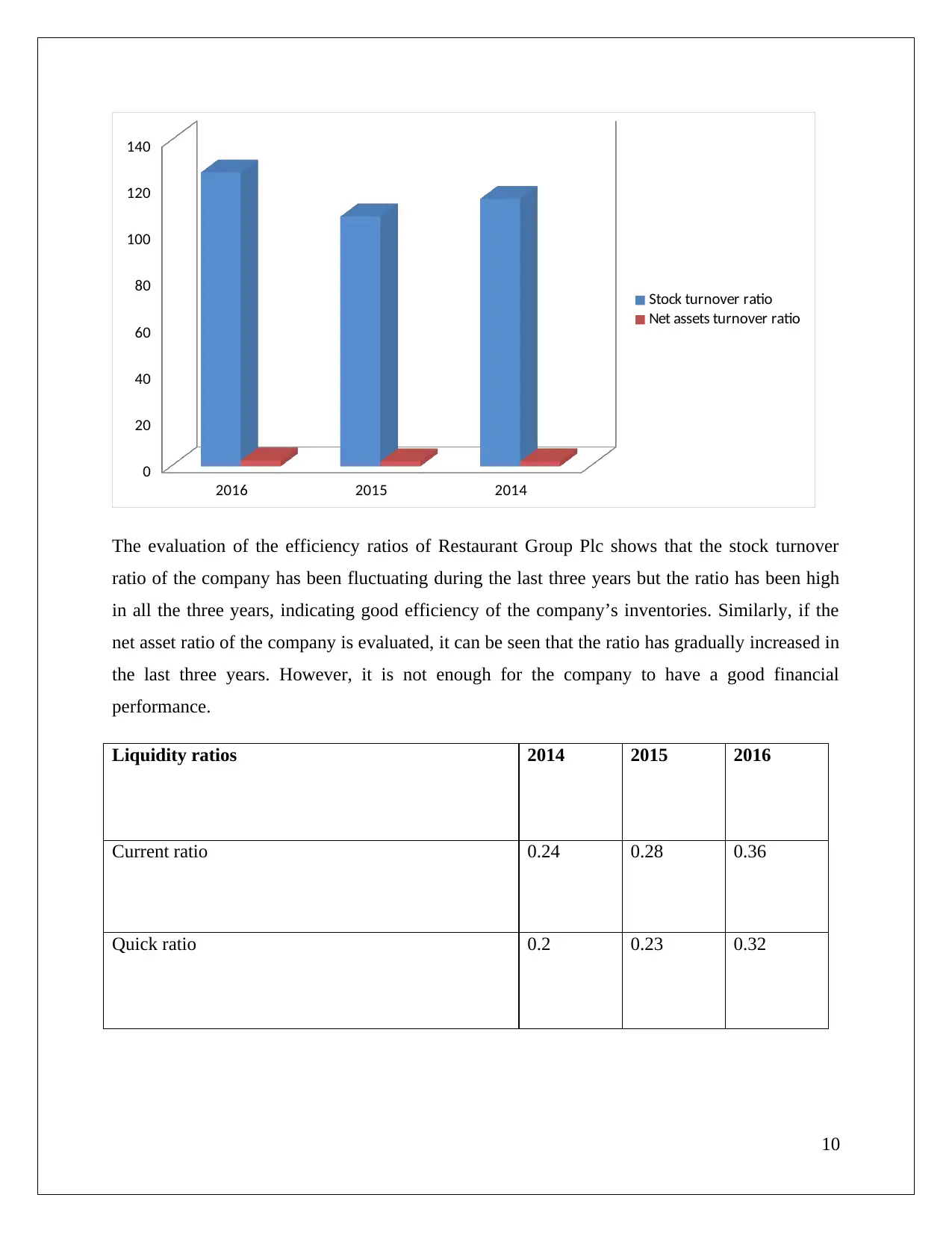
2016 2015 2014
0
20
40
60
80
100
120
140
Stock turnover ratio
Net assets turnover ratio
The evaluation of the efficiency ratios of Restaurant Group Plc shows that the stock turnover
ratio of the company has been fluctuating during the last three years but the ratio has been high
in all the three years, indicating good efficiency of the company’s inventories. Similarly, if the
net asset ratio of the company is evaluated, it can be seen that the ratio has gradually increased in
the last three years. However, it is not enough for the company to have a good financial
performance.
Liquidity ratios 2014 2015 2016
Current ratio 0.24 0.28 0.36
Quick ratio 0.2 0.23 0.32
10
0
20
40
60
80
100
120
140
Stock turnover ratio
Net assets turnover ratio
The evaluation of the efficiency ratios of Restaurant Group Plc shows that the stock turnover
ratio of the company has been fluctuating during the last three years but the ratio has been high
in all the three years, indicating good efficiency of the company’s inventories. Similarly, if the
net asset ratio of the company is evaluated, it can be seen that the ratio has gradually increased in
the last three years. However, it is not enough for the company to have a good financial
performance.
Liquidity ratios 2014 2015 2016
Current ratio 0.24 0.28 0.36
Quick ratio 0.2 0.23 0.32
10
Secure Best Marks with AI Grader
Need help grading? Try our AI Grader for instant feedback on your assignments.
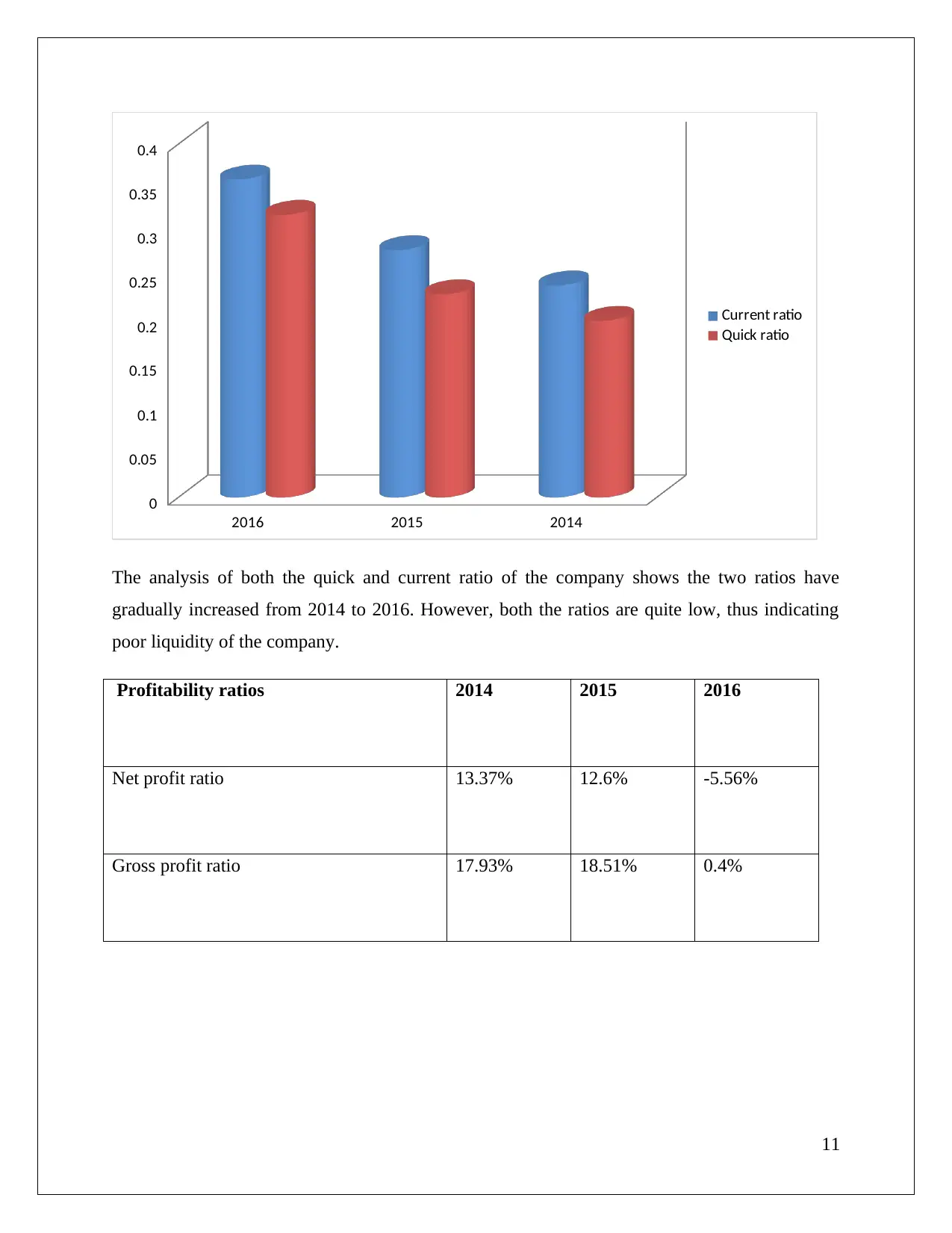
2016 2015 2014
0
0.05
0.1
0.15
0.2
0.25
0.3
0.35
0.4
Current ratio
Quick ratio
The analysis of both the quick and current ratio of the company shows the two ratios have
gradually increased from 2014 to 2016. However, both the ratios are quite low, thus indicating
poor liquidity of the company.
Profitability ratios 2014 2015 2016
Net profit ratio 13.37% 12.6% -5.56%
Gross profit ratio 17.93% 18.51% 0.4%
11
0
0.05
0.1
0.15
0.2
0.25
0.3
0.35
0.4
Current ratio
Quick ratio
The analysis of both the quick and current ratio of the company shows the two ratios have
gradually increased from 2014 to 2016. However, both the ratios are quite low, thus indicating
poor liquidity of the company.
Profitability ratios 2014 2015 2016
Net profit ratio 13.37% 12.6% -5.56%
Gross profit ratio 17.93% 18.51% 0.4%
11

2016 2015 2014
-10
-5
0
5
10
15
20
Net profit ratio
Gross profit ratio
The analysis of the gross and net profit ratio of the company shows that the company’s profits
have terribly decreased from 2014 to 2016, which indicates a major fall in the company’s profits.
The company is presently running at losses.
Solvency ratios 2014 2015 2016
Debt to equity ratio 0.24 0.65072 1.01584
Debt ratio 0.14 0.3942 0.50393
12
-10
-5
0
5
10
15
20
Net profit ratio
Gross profit ratio
The analysis of the gross and net profit ratio of the company shows that the company’s profits
have terribly decreased from 2014 to 2016, which indicates a major fall in the company’s profits.
The company is presently running at losses.
Solvency ratios 2014 2015 2016
Debt to equity ratio 0.24 0.65072 1.01584
Debt ratio 0.14 0.3942 0.50393
12
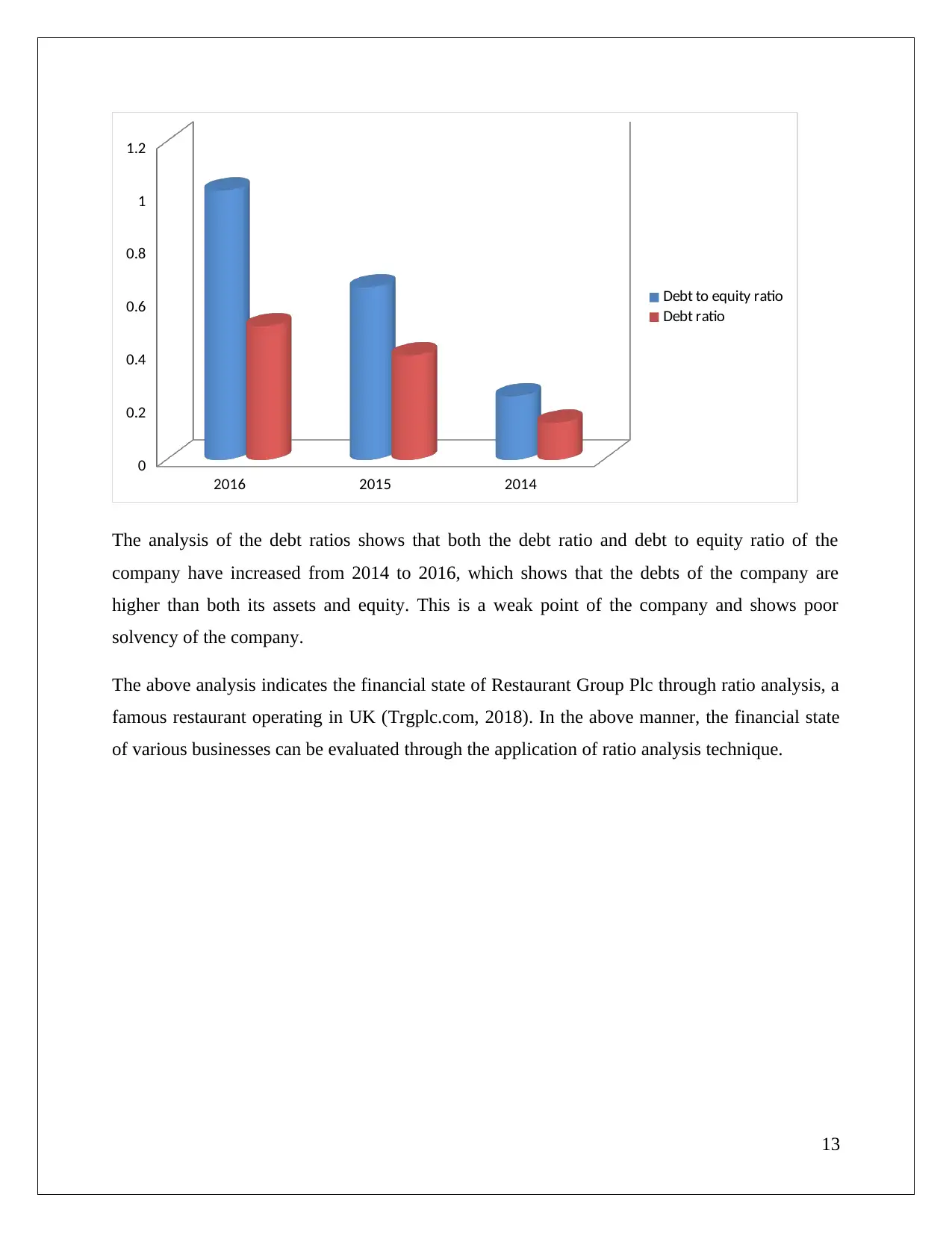
2016 2015 2014
0
0.2
0.4
0.6
0.8
1
1.2
Debt to equity ratio
Debt ratio
The analysis of the debt ratios shows that both the debt ratio and debt to equity ratio of the
company have increased from 2014 to 2016, which shows that the debts of the company are
higher than both its assets and equity. This is a weak point of the company and shows poor
solvency of the company.
The above analysis indicates the financial state of Restaurant Group Plc through ratio analysis, a
famous restaurant operating in UK (Trgplc.com, 2018). In the above manner, the financial state
of various businesses can be evaluated through the application of ratio analysis technique.
13
0
0.2
0.4
0.6
0.8
1
1.2
Debt to equity ratio
Debt ratio
The analysis of the debt ratios shows that both the debt ratio and debt to equity ratio of the
company have increased from 2014 to 2016, which shows that the debts of the company are
higher than both its assets and equity. This is a weak point of the company and shows poor
solvency of the company.
The above analysis indicates the financial state of Restaurant Group Plc through ratio analysis, a
famous restaurant operating in UK (Trgplc.com, 2018). In the above manner, the financial state
of various businesses can be evaluated through the application of ratio analysis technique.
13
Paraphrase This Document
Need a fresh take? Get an instant paraphrase of this document with our AI Paraphraser
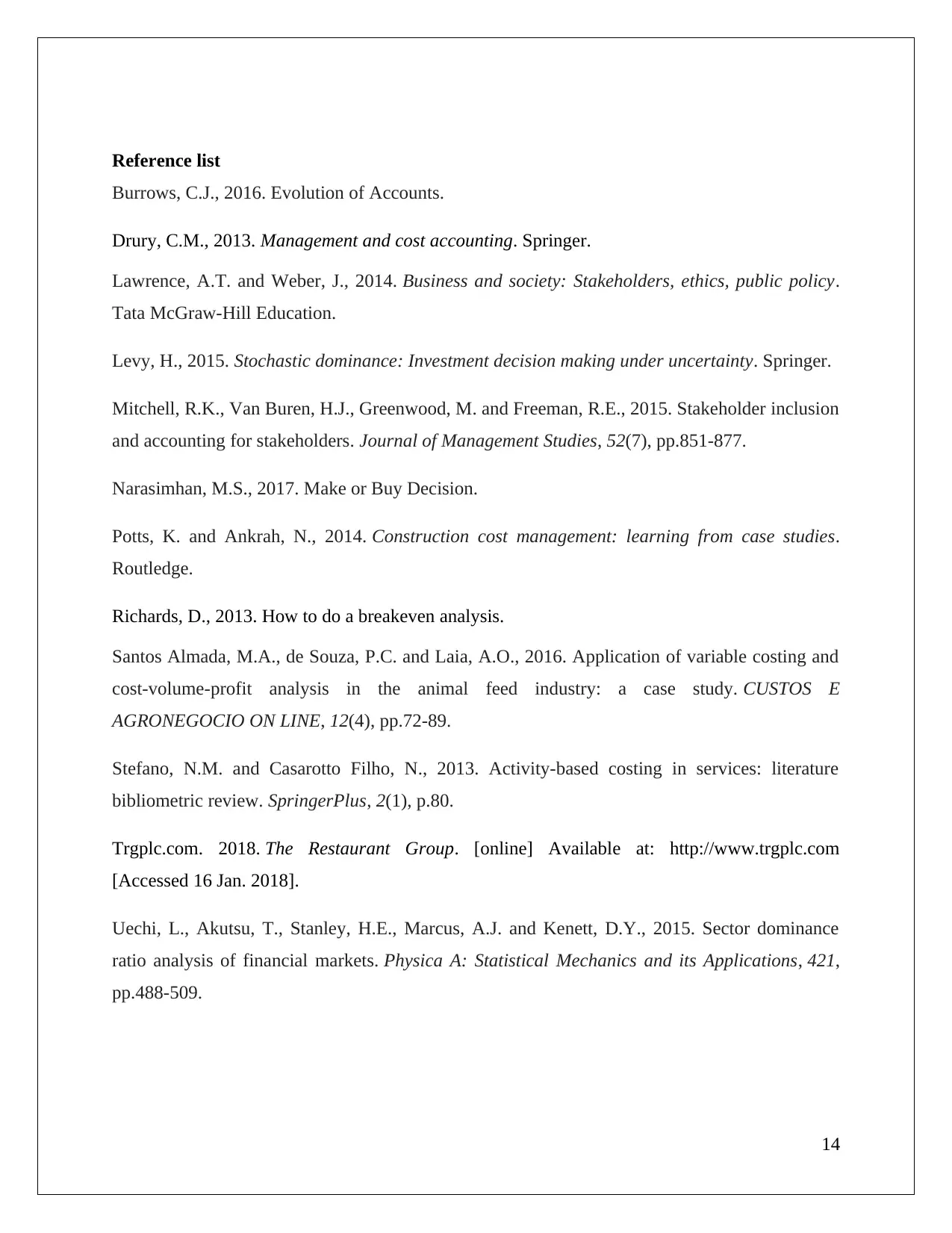
Reference list
Burrows, C.J., 2016. Evolution of Accounts.
Drury, C.M., 2013. Management and cost accounting. Springer.
Lawrence, A.T. and Weber, J., 2014. Business and society: Stakeholders, ethics, public policy.
Tata McGraw-Hill Education.
Levy, H., 2015. Stochastic dominance: Investment decision making under uncertainty. Springer.
Mitchell, R.K., Van Buren, H.J., Greenwood, M. and Freeman, R.E., 2015. Stakeholder inclusion
and accounting for stakeholders. Journal of Management Studies, 52(7), pp.851-877.
Narasimhan, M.S., 2017. Make or Buy Decision.
Potts, K. and Ankrah, N., 2014. Construction cost management: learning from case studies.
Routledge.
Richards, D., 2013. How to do a breakeven analysis.
Santos Almada, M.A., de Souza, P.C. and Laia, A.O., 2016. Application of variable costing and
cost-volume-profit analysis in the animal feed industry: a case study. CUSTOS E
AGRONEGOCIO ON LINE, 12(4), pp.72-89.
Stefano, N.M. and Casarotto Filho, N., 2013. Activity-based costing in services: literature
bibliometric review. SpringerPlus, 2(1), p.80.
Trgplc.com. 2018. The Restaurant Group. [online] Available at: http://www.trgplc.com
[Accessed 16 Jan. 2018].
Uechi, L., Akutsu, T., Stanley, H.E., Marcus, A.J. and Kenett, D.Y., 2015. Sector dominance
ratio analysis of financial markets. Physica A: Statistical Mechanics and its Applications, 421,
pp.488-509.
14
Burrows, C.J., 2016. Evolution of Accounts.
Drury, C.M., 2013. Management and cost accounting. Springer.
Lawrence, A.T. and Weber, J., 2014. Business and society: Stakeholders, ethics, public policy.
Tata McGraw-Hill Education.
Levy, H., 2015. Stochastic dominance: Investment decision making under uncertainty. Springer.
Mitchell, R.K., Van Buren, H.J., Greenwood, M. and Freeman, R.E., 2015. Stakeholder inclusion
and accounting for stakeholders. Journal of Management Studies, 52(7), pp.851-877.
Narasimhan, M.S., 2017. Make or Buy Decision.
Potts, K. and Ankrah, N., 2014. Construction cost management: learning from case studies.
Routledge.
Richards, D., 2013. How to do a breakeven analysis.
Santos Almada, M.A., de Souza, P.C. and Laia, A.O., 2016. Application of variable costing and
cost-volume-profit analysis in the animal feed industry: a case study. CUSTOS E
AGRONEGOCIO ON LINE, 12(4), pp.72-89.
Stefano, N.M. and Casarotto Filho, N., 2013. Activity-based costing in services: literature
bibliometric review. SpringerPlus, 2(1), p.80.
Trgplc.com. 2018. The Restaurant Group. [online] Available at: http://www.trgplc.com
[Accessed 16 Jan. 2018].
Uechi, L., Akutsu, T., Stanley, H.E., Marcus, A.J. and Kenett, D.Y., 2015. Sector dominance
ratio analysis of financial markets. Physica A: Statistical Mechanics and its Applications, 421,
pp.488-509.
14
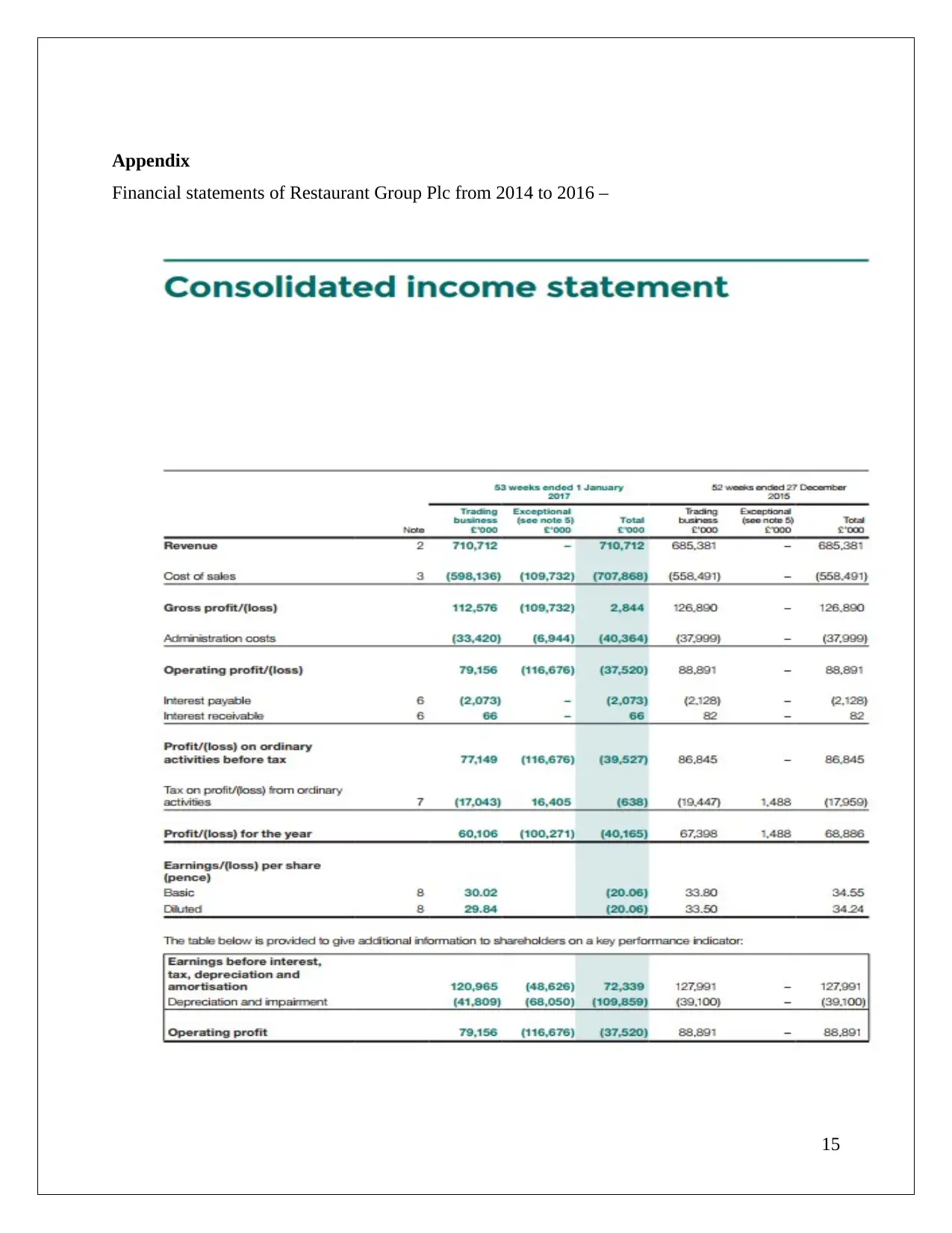
Appendix
Financial statements of Restaurant Group Plc from 2014 to 2016 –
15
Financial statements of Restaurant Group Plc from 2014 to 2016 –
15

(Source: Trgplc.com, 2018)
16
16
Secure Best Marks with AI Grader
Need help grading? Try our AI Grader for instant feedback on your assignments.
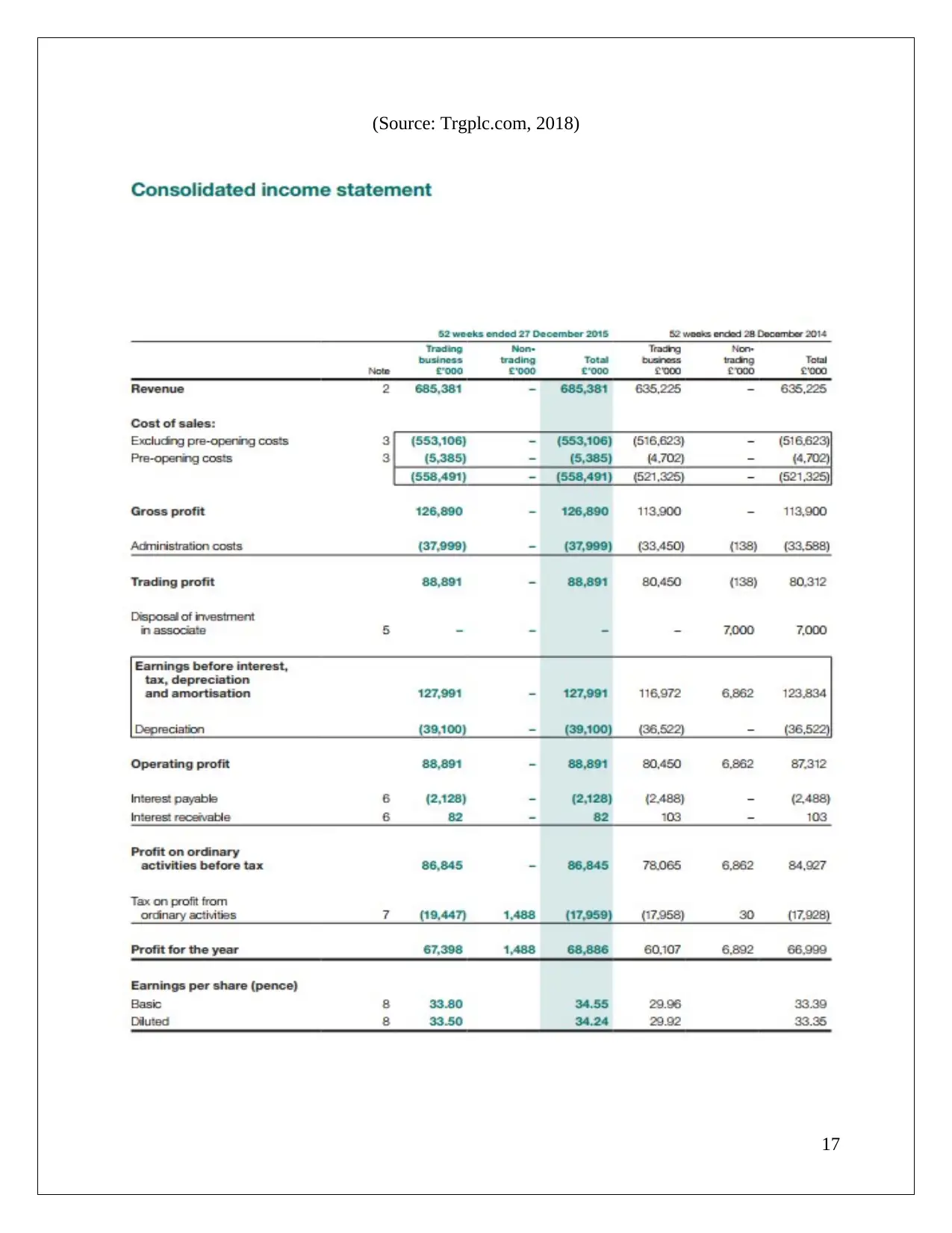
(Source: Trgplc.com, 2018)
17
17
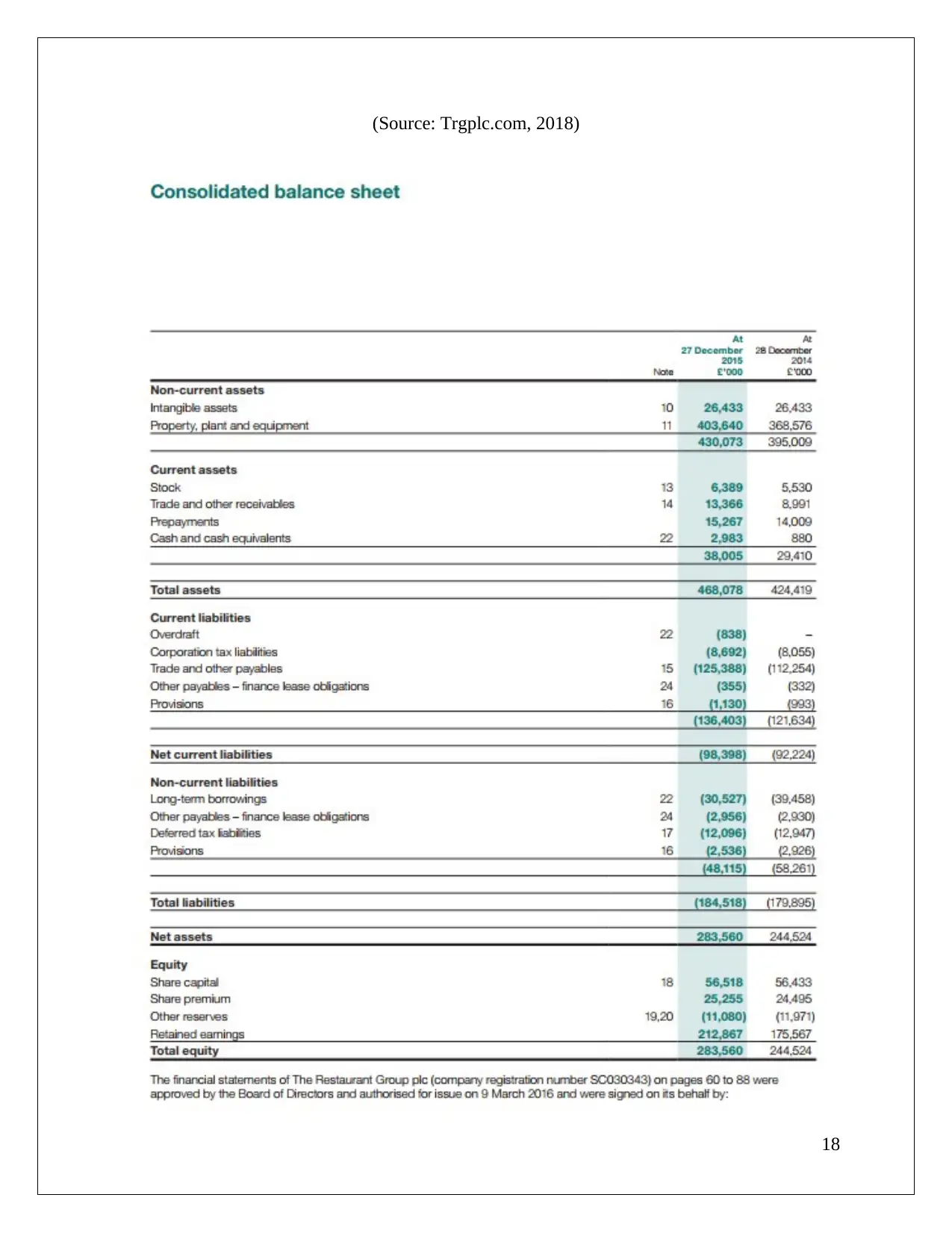
(Source: Trgplc.com, 2018)
18
18

(Source: Trgplc.com, 2018)
19
19
1 out of 19
Related Documents
Your All-in-One AI-Powered Toolkit for Academic Success.
+13062052269
info@desklib.com
Available 24*7 on WhatsApp / Email
![[object Object]](/_next/static/media/star-bottom.7253800d.svg)
Unlock your academic potential
© 2024 | Zucol Services PVT LTD | All rights reserved.





